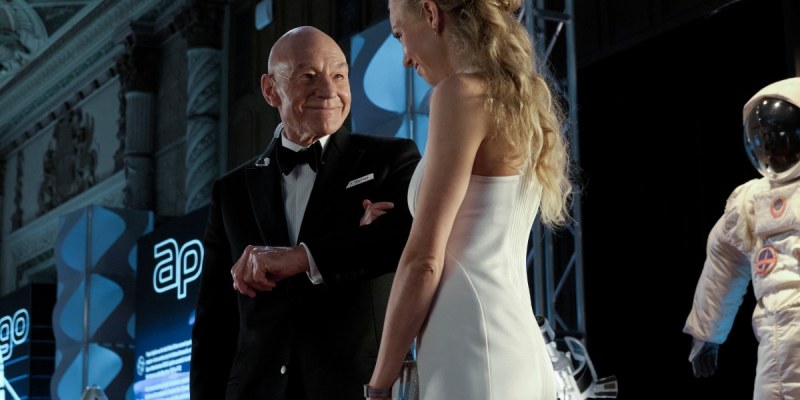This discussion and review contains some spoilers for Star Trek: Picard season 2, episode 6, “Two of One” (and Star Trek IV: The Voyage Home, if you somehow never saw that).
Given how much the second season of Star Trek: Picard owes to Star Trek IV: The Voyage Home, it is worth taking a moment to consider what The Voyage Home is actually about.
On the surface, The Voyage Home is a time travel story. When an alien probe arrives on Earth and wreaks devastation trying to communicate with extinct humpback whales, Kirk (William Shatner) leads the crew of the Enterprise back in time to recover two humpback whales from the late 20th century. A series of comedic fish-out-of-water setups ensue, with the visitors from the future awkwardly navigating the hostile world outside the audience’s cinema.
However, there is something more at play within The Voyage Home. In some ways, The Voyage Home is as much a spiritual companion to Who Framed Roger Rabbit? as it is to Back to the Future. It isn’t just about time travelers from an imaginary future; it is about fugitives from television. Kirk and his crew are inherently absurd figures who have somehow broken free of the imaginary world of 1960s science fiction television and landed in Reagan’s America.
This is obvious in the emphasis that The Voyage Home places on the cast’s inability to convincingly swear — “double dumbass on you!” After all, it is ridiculous to assume that a future that preserved Shakespeare, Mozart, Bach, and countless others would have forgotten words like “merde” and “shit.” The reason Kirk cannot swear is not because those words will be eliminated from future vocabularies, but because the harshest curse a 1960s television character could utter was “hell.”

This gets at the often overlooked genius of The Voyage Home, which is that it is a story that confronts relics of 1960s science fiction utopianism with the realities of 1980s America. To quote blogger Jack Graham, it is a story about “ageing progressives from another time (coming) to Reagan’s America.” It is about collapsing imagined futures into a disillusioned present, as well as the conflict that results from having those two elements at play with one another.
Star Trek: Picard season 2 lifts quite a lot from The Voyage Home. The slingshot maneuver that the crew employed to travel back in time in “Assimilation” was the same one that Kirk used in The Voyage Home. Indeed, the second season of Picard marks the first time that this trick has been employed since The Voyage Home. “Watcher” also featured a cameo from Kirk Thatcher reprising his role as the angry punk from The Voyage Home, even recording an updated version of the same song.
As in The Voyage Home, Jean-Luc Picard (Patrick Stewart) and his crew are operating a stolen craft with a cloaking device. As in The Voyage Home, that stolen craft has landed on the planet’s surface but is obscured from human eyes. As in The Voyage Home, this time travel story is ultimately a none-too-subtle allegory about a pressing real-world concern. In The Voyage Home, that concern was the environmentalist movement. In Picard, that concern is immigration.
Of course, there are some key differences between Star Trek: Picard season 2 and The Voyage Home. Given that the characters are escaping from a 2020s streaming service instead of 1960s broadcast television, they blend in a lot easier to the modern world. The cast is capable of swearing, and they can engage in sex and violence just like real human beings, without worrying about upsetting the censors. However, the core ideas carry across.

Notably, “Two of One” positions Jean-Luc Picard as something akin to guardian angel for his distant relative Renée (Penelope Mitchell). Much of Renée’s arc in “Fly Me to the Moon” and “Two of One” consists of the character feeling powerless and helpless, as if her choices and actions do not matter. While Jean-Luc cannot physically complete her task for her, or even help directly, he can offer moral support. Picard can offer advice and wisdom, perhaps even inspiration for the task ahead.
Renée is even overtly aware of Jean-Luc’s passivity. “I don’t suppose you want to catch a ride to Europa?” she asks. “You could hang in the cockpit, keep everyone calm?” She doesn’t expect him to lead the mission or to provide any meaningful function. Instead, she suggests that his mere presence could be reassuring to the real people who are doing the real work. It’s a striking take on the question of what Star Trek means in a chaotic and turbulent world.
Both “Fly Me to the Moon” and “Two of One” return to the theme of passivity and observation. Tallinn (Orla Brady) has spent years watching Renée as a “Watcher” who works for a “Supervisor,” but she has never interacted with her. “I watch, but I’m never seen,” Tallinn explains in “Fly Me to the Moon.” “You’ve never spoken to her in all those years?” Picard asks in “Two of One.” Tallinn responds, “It’s not just a rule; it’s a code we live by.” It seems the television set works both ways.
After all, even though Star Trek is not real, it has had a meaningful and inspirational effect on many lives. Whoopi Goldberg has spoken about how seeing Nichelle Nichols on the original Star Trek was an important moment for her. Astronaut Mae Jemison has argued that Nichols was a major inspiration on her choice of profession. President Barack Obama has spoken a great deal about what Star Trek means to him and what he has learned from it.

“Two of One” serves to position the characters as ambassadors from Star Trek into something resembling the real world, making an argument for the importance of the franchise’s utopian values in a world where individuals (particularly from younger generations) can often feel depressed or hopeless. One of the core appeals of Star Trek is the hope that the future will be better — arguably a quintessentially American ideal. What does it mean when people stop believing that?
“Two of One” makes this explicit with the character of Adam Soong (Brent Spiner) and his daughter Kore (Isa Briones). “I poured my heart into you,” Soong tells her. “I let myself believe you were the one; you’d make it.” Describing Kore as his “life’s work,” Soong embodies a recognizable sentiment. He speaks for a generation that believes their children will not inherit a better life at all. It seems that Soong has become disillusioned to the point of nihilism and is driven to do terrible things.
One of the more interesting elements of Star Trek: Picard season 2 is the emphasis that it places on the importance of mental health. In some ways, this perhaps represents a tempering of the franchise’s longstanding utopianism, to better reflect an age where climate change may already be past the point where it can be reversed, where the political system may already be beyond repair, and where even modest goals like home ownership are out of reach for many young people.
It makes sense that the second season of Picard is largely about the way that the characters respond to these sorts of existential pressures, with the understanding that maybe they cannot change the world singlehandedly. In “Fly Me to the Moon,” Tallinn notes that Renée has her demons: “sometimes anxiety, sometimes depression.” The show understands that depression doesn’t always manifest in obvious ways. “She’s gotten pretty good at putting on an act,” Tallinn explains.

This theme carries across to the primary cast. For the first time, the relationship between the Borg Queen (Annie Wersching) and Jurati (Alison Pill) makes sense, with the Queen positioned as Jurati’s worst impulses. “I’m trying to help you understand that good things happen when you lose control,” the Queen goads, the embodiment of Jurati’s worst self. Similarly, Raffi (Michelle Hurd) is still haunted by visions of Elnor (Evan Evagora), while Seven (Jeri Ryan) is freed of her Borg scars.
There is something interesting in this, particularly in the context of Picard as a sequel to The Next Generation. One of Gene Roddenberry’s most derided decisions on The Next Generation was to put a mental health professional on the bridge of the Enterprise, seating counselor Deanna Troi (Marina Sirtis) next to Picard. It is an understatement to suggest that The Next Generation had no real idea what to do with Troi. So Picard’s emphasis on mental health is an intriguing development.
In some ways, “Two of One” feels quite like the episode that “Watcher” wanted to be. It feels very much like a relaxed breather episode. The party setting helps, allowing for a variety of low-key character moments with the ensemble. It is nice to see Seven enjoying the act of socializing without her Borg implants. Jurati’s musical number is goofy, but in keeping with the franchise’s rich history. Patrick Stewart looks great in a tuxedo. The cast seem to be enjoying themselves.
Of course, there are limitations. Modern Star Trek is too propulsive to fully commit to a low-stakes character-driven hour of television, so “Two of One” features a frustrating in medias res framing device that constantly assures the audience that the episode will contain at least one action scene. It’s distracting and unnecessary, adding nothing to the storytelling and suggesting that the episode doesn’t trust the audience’s attention span.
“Two of One” is another solid episode of Star Trek: Picard, albeit one that comes with many of the show’s core flaws baked into the mix. Still, the second season continues to come into focus in compelling ways.
